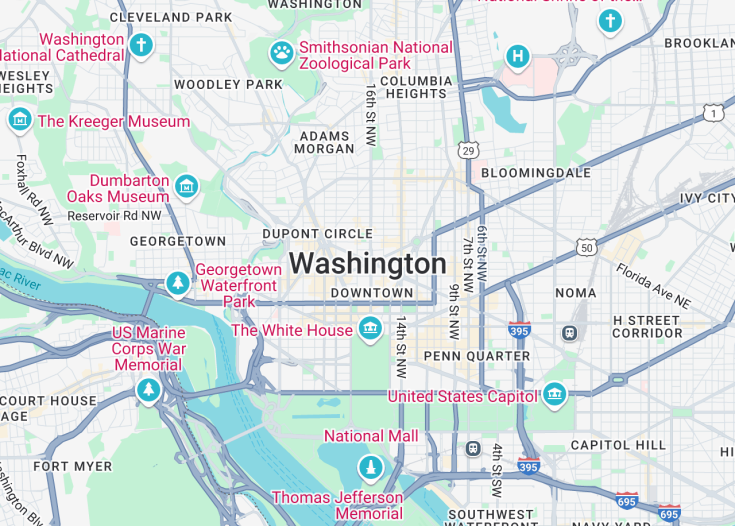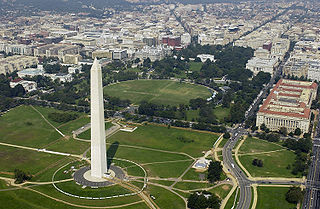Washington D.C. stands as a pinnacle of historical richness melded with vibrant, contemporary culture. The U.S. capital mesmerizes with its iconic landmarks such as the U.S. Capitol, the White House, and the Supreme Court. Museums abound, led by the Smithsonian Institution offering vast collections of national artifacts. This city also unfolds a tapestry of exquisite dining, lively nightlife, and diverse neighborhoods like Georgetown and Adams-Morgan, each with its unique charm and history.
Plan to explore the National Mall early in the morning to avoid crowds and experience the monuments in a quieter, more personal ambience.
Consider investing in a multi-day pass for the Metro system, which offers an economical and efficient way to navigate Washington D.C. and explore its diverse neighborhoods.
Top things to do & see in Washington D.C.
Select the following sights and activities to discover best tickets and tours available in Washington D.C..
Washington D.C.: A Vibrant Hub of History and Culture
| Country | Washington State (USA) |
| Time in Washington D.C. | GMT-5 |
| Language spoken | English |
| Population | 705,749 (According to the U.S. Census Bureau, 2020) |
| Currency | United States Dollar (USD $) |
| Airports |
|
Washington D.C. is uniquely positioned as the nation’s capital and a symbol of the United States. Known for its significant landmarks such as the White House, Capitol Building, and numerous nationally recognized museums and memorials, Washington D.C. plays a pivotal role in the country’s history and governance. This city is not just the seat of power; it is a place where history is alive in the plethora of archives and libraries, making it a pivotal area for research and study. Washington D.C. also features vibrant neighborhoods like Georgetown, diverse culinary scenes, and a dynamic community engaged in political and social discourse.
Where is Washington D.C.?
Located along the Potomac River, bordering the states of Maryland and Virginia, Washington D.C. is strategically positioned on the east coast of the United States.
Distances:
| Route | Distance by car | Time by car |
|---|---|---|
| New York to D.C. | 225 miles | 4-5 hours |
| Philadelphia to D.C. | 140 miles | 2.5-3 hours |
What is Washington D.C.famous for?
Washington D.C. is renowned for its profound historical significance, vast collections of public museums and art galleries that are largely part of the Smithsonian Institution, the U.S. Capitol, and countless monuments and memorials dedicated to American leaders and national events.
History
Indigenous Roots and European Settlement (1600s-1790)
Washington D.C.’s history dates back to the early 1600s when the area was populated by indigenous tribes who lived along the Potomac River. They thrived through fishing, hunting, and gathering. The first European to record sight of the region was Captain John Smith in 1608, who explored parts of the Chesapeake Bay and its tributaries. However, colonisation was slow until the late 17th century when trade and strategic interests boosted settlements.
Federal City Design and Development (1791-1800)
In 1791, President George Washington commissioned Pierre Charles L’Enfant to design a grand capital city on the banks of the Potomac River. Resplendent with broad avenues and inspiring public squares, L’Enfant’s design laid the foundations for a significant political hub. The city, named in Washington’s honor, officially became the United States capital in 1800.
Growth and Civil War (1801-1865)
Washington D.C. rapidly evolved through the 19th century but faced significant challenges, including the British attack during the War of 1812, which led to burning significant landmarks like the White House. The Civil War era saw an increase in the population due to freed slaves settling in the city; however, it also made Washington a strategic target. The construction of fortifications and barracks ensued, heightening the military atmosphere of the capital.
Reconstruction and the 20th Century (1866-2000)
Post-Civil War, Washington D.C. underwent extensive reconstruction. The city modernized through the introduction of electric streetcars in the late 19th century, and grand cultural institutions were established such as the National Museum (later known as the Smithsonian Institution). The 20th century marked significant political and social milestones such as the civil rights movements aligning with the city’s status as a symbol of freedom and leadership. The cityscape also evolved, with iconic monuments like the Lincoln Memorial and the Washington Monument being constructed, embodying national virtues and commemorations.
Modern Era and Present Day (2001 – Present)
Washington D.C. entered the 21st century as a vibrant metropolis reflecting a complex blend of political authority and cultural heritage. The city has faced its share of challenges such as concerns over security and political partisanship, yet it continues to stand as a beacon of democracy and progress. Significant developments have included the revitalization of city areas and neighborhoods, enhancing liveability and sustainability amidst growing global challenges.
Visit Washington D.C.
Exploring D.C.: Landmarks and Leisure
Washington D.C. offers a robust array of iconic landmarks and engaging activities. Key attractions include the U.S. Capitol, where visitors can observe politics in action, and the Smithsonian Museums showcasing vast collections of art, history, and science. Outdoor enthusiasts will appreciate the expansive National Mall, leading to the stoic Lincoln Memorial. Culture seekers should not miss performances at the Kennedy Center.
- U.S. Capitol
- Smithsonian Museums
- National Mall
- Lincoln Memorial
- Kennedy Center
Capital Celebrations
Washington D.C. is alive with vibrant events year-round. The National Cherry Blossom Festival in spring draws crowds with beautiful blooms and cultural performances. Independence Day is famously celebrated with a stunning fireworks display over the National Mall. The fall brings the crisp excitement of the Environmental Film Festival, highlighting pressing global issues through powerful cinematography.
Best time to visit Washington D.C.
Spring (March to May) and fall (September to November) are ideal times to visit Washington D.C., thanks to mild weather and fewer crowds—perfect for enjoying the outdoor attractions and numerous festivals. Summers can be hot and crowded, while winters, though quiet, tend to be cold.
is Washington D.C. worth visiting?
Washington D.C. stands out as a destination with profound historical significance and a vibrant cultural scene. Visitors can appreciate the meticulously curated museums, architectural grandeur, and scenic parks. However, one should be prepared for potential crowds during peak seasons and heightened security measures around key areas. Nevertheless, the rich experiences offered make it a worthwhile visit for those eager to delve into the roots of American history and culture.











